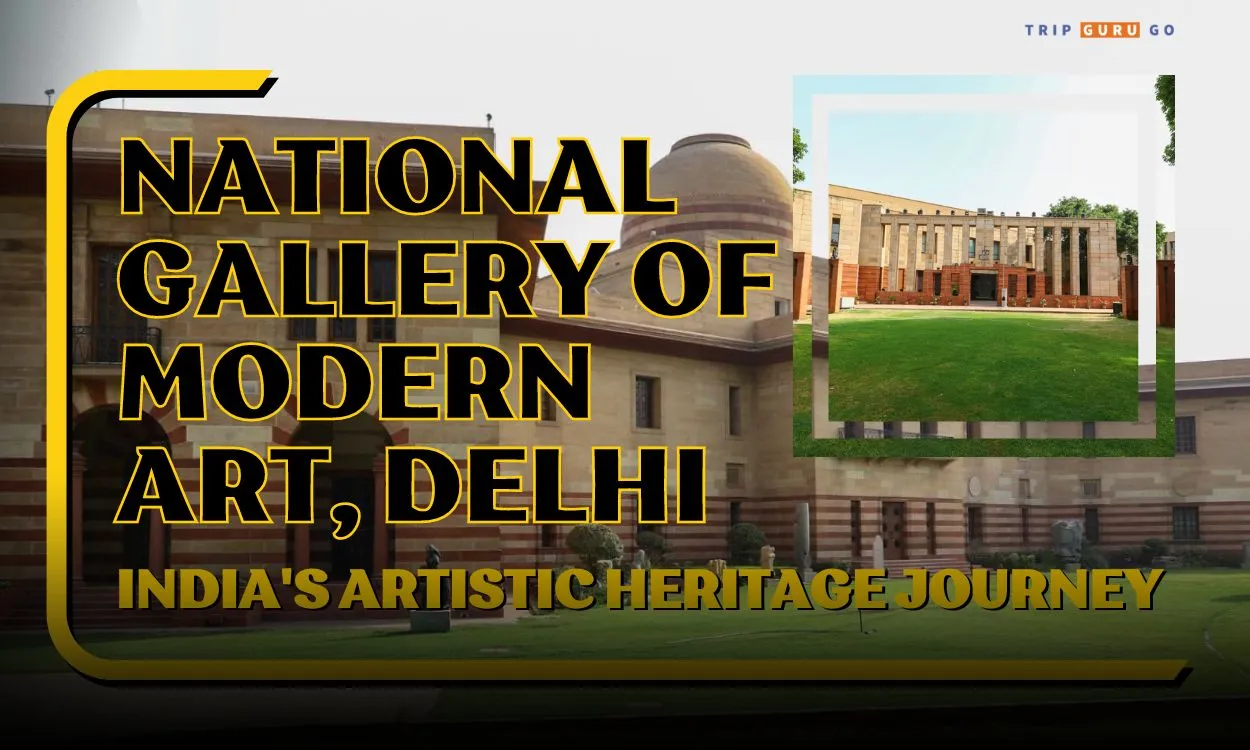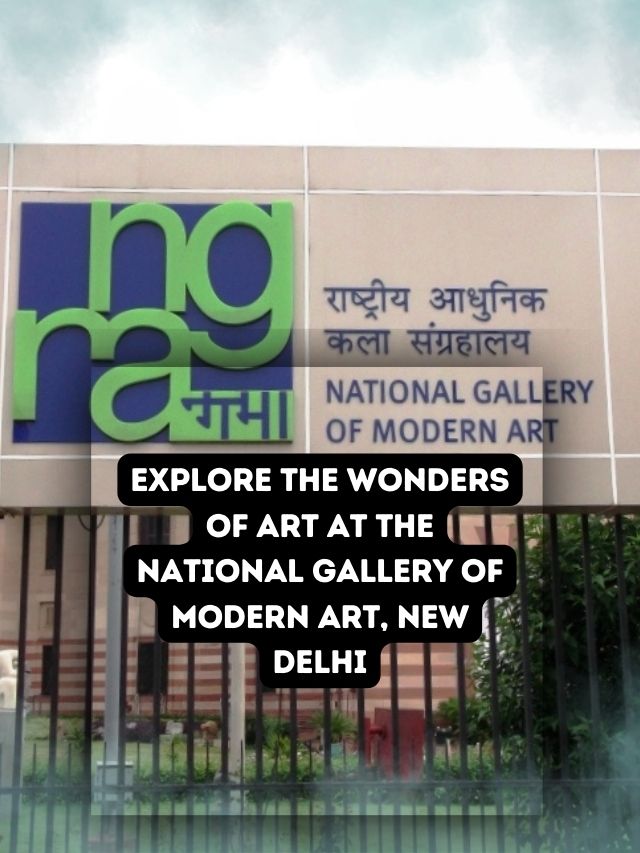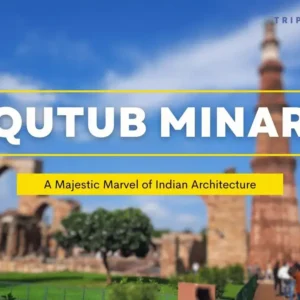Introduction – India’s Artistic Heritage Journey
The National Gallery of Modern Art (NGMA) in New Delhi stands as a testament to India’s rich artistic heritage and cultural identity. Established with a vision to promote modern art and nurture creativity, NGMA showcases an extensive collection of masterpieces from eminent artists across the country. This article explores NGMA’s history, art collections, architecture, and contributions to art education and awareness, making it one of the best places to visit in Delhi 2024 for art enthusiasts and cultural explorers.
History of the National Gallery of Modern Art (NGMA)
NGMA was founded on March 29, 1954, by the Indian Government to showcase and preserve contemporary art. Its foundation stone was laid by the renowned artist Sir C.V. Raman. The gallery started at Jaipur House, New Delhi, and later moved to its present location near India Gate. Over the years, NGMA has played a pivotal role in elevating Indian art to international acclaim.
The Evolution of the National Gallery of Modern Art (NGMA)
NGMA, founded in 1954 by PM Jawaharlal Nehru, promotes and preserves modern art in India. Initially at Jaipur House, it moved to Shershah Suri Marg near India Gate, featuring Sir Arthur Blomfield’s stunning design.
- Vast Collection: NGMA houses diverse artworks, including paintings, sculptures, prints, and photographs, expanding its collection over the years.
- National and International Artists: The gallery collects and exhibits art from Indian and international artists, showing modern art trends comprehensively.
- Regional Branches: NGMA has branches in Bengaluru and Mumbai, promoting art in different parts of India.
- Artistic Engagement: Through exhibitions, workshops, and educational programs, NGMA nurtures talents and engages art enthusiasts.
- Cultural Preservation: NGMA plays a vital role in preserving India’s cultural heritage and supporting contemporary art’s growth.
- Inspiring Space: NGMA inspires artists and art lovers, fostering a vibrant platform for modern art appreciation in India.
NGMA stands as a beacon of artistic expression, fostering creativity and celebrating the beauty of modern art. Through dynamic exhibitions and educational initiatives, NGMA influences India’s art world, leaving a lasting impact on future generations.
Architectural Marvel of the National Gallery of Modern Art
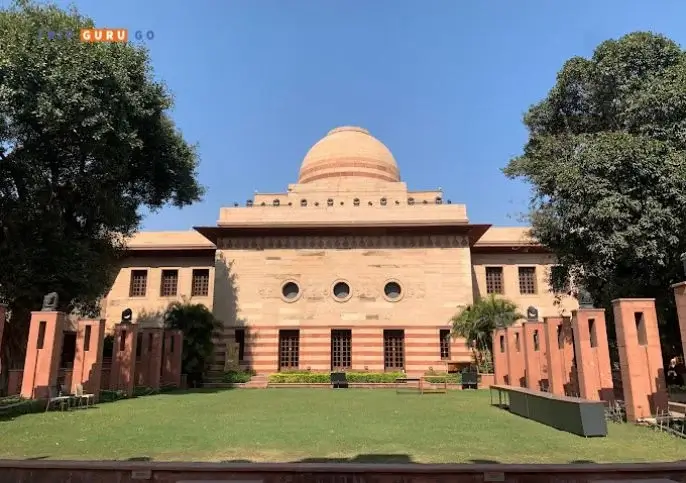
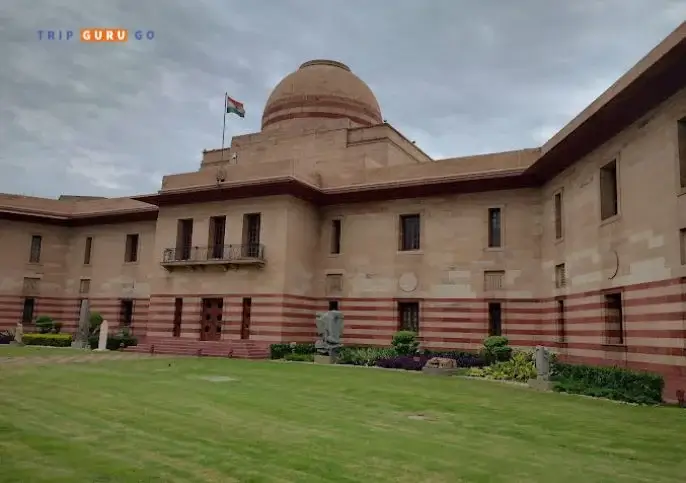
The NGMA building itself is an architectural marvel, designed by the renowned architect Sir Arthur Blomfield. The majestic structure, once the Maharaja of Jaipur’s residence, combines Indian and British architectural elements. This fusion of styles creates an ambiance that enhances the appreciation of the art displayed within its walls.
- Majestic Facade: NGMA’s exterior has an imposing facade, and intricate detailing, blending classical and contemporary architecture.
- Spacious Galleries: Inside, the gallery offers spacious halls and galleries, that provide the perfect backdrop for displaying diverse national galleries of modern artworks.
- Natural Light: Skylights and large windows provide ample natural light, enhancing the viewing experience inside NGMA.
- Artistic Harmony: The architectural design of NGMA seamlessly complements the displayed artworks, creating a harmonious ambiance for visitors.
- Serene Landscaping: The gallery is surrounded by well-maintained gardens and landscaping, providing a serene environment for contemplation and leisure.
NGMA’s architecture blends art with a thoughtfully designed space, elevating art appreciation in India. Visitors experience immersive artistry in form and structure, showcasing the gallery’s architectural splendor.
Diverse Collections at the National Gallery Of Modern Art Delhi
The National Gallery of Modern Art showcases a remarkable collection of Indian art dating from the 1750s to the present. The carefully curated collection boasts an impressive 17,039 artworks, making it one of the largest compilations of modern and contemporary Indian art in one place. The collection represents the works of 2,000 diverse and talented artists, offering a wide range of artistic expressions. The museum features traditional mediums and masterpieces of digital and installation art.
NGMA houses an extensive and diverse collection of art, spanning various forms and mediums. The collections are categorized into three major sections:
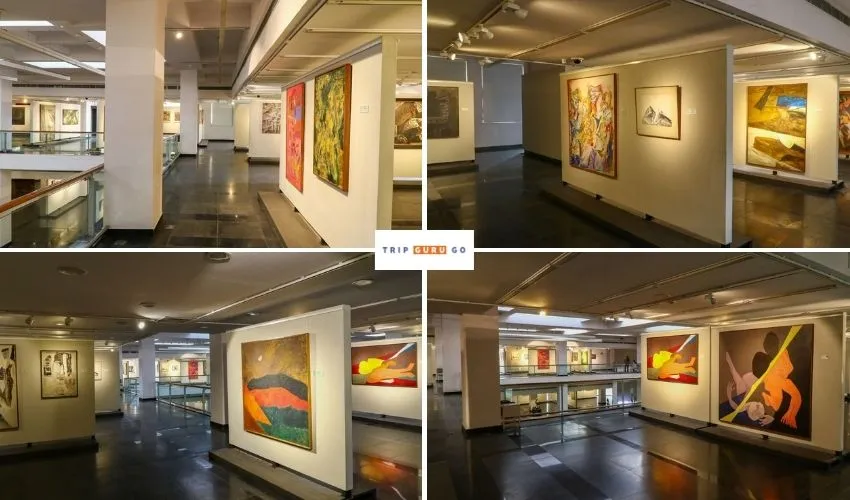
Masterpieces of Indian Artists:
NGMA displays masterpieces by Indian artists Raja Ravi Varma, Rabindranath Tagore, Amrita Sher-Gil, and Tyeb Mehta, showcasing cultural heritage.
Paintings and Sculptures:
The gallery boasts an impressive array of paintings and sculptures dating back to the 18th century. Witness Indian art evolution with works by iconic artists like Raja Ravi Varma, Jamini Roy, and Rabindranath Tagore. Sculptures crafted by masters like Ramkinkar Baij and Dhanraj Bhagat add depth to the collection.
Photography and Prints:
In addition to paintings and sculptures, NGMA proudly exhibits a substantial collection of vintage photographs and prints. These visual chronicles capture historical events, cultural nuances, and the essence of India’s vibrant diversity.
Textiles and Crafts:
The gallery houses captivating textiles and crafts, showcasing artistic brilliance from diverse regions and communities in India. From intricate textiles to exquisite pottery, these artifacts narrate tales of India’s rich cultural tapestry.
International Artists:
The gallery exhibits renowned international artists, providing a global perspective on modern art and fostering cross-cultural dialogues.
Prominent Artists and Their Masterpieces
Within NGMA, iconic artists’ masterpieces leave an indelible mark on Indian art. Some of the prominent artists and their celebrated works include:
- Raja Ravi Varma: The Pioneer of Indian Modern Art: Raja Ravi Varma’s exquisite paintings, such as “Hamsa Damayanti” and “Shakuntala,” are timeless classics that epitomize his mastery of portraying Indian mythological characters with European academic realism.
- Amrita Sher-Gil: The Woman of Substance: Amrita Sher-Gil, a trailblazer among Indian women artists, graces NGMA with her celebrated pieces like “Self-Portrait with a Palette” and “The Brahmacharis.” Her art reflects a poignant fusion of Western techniques and Indian themes.
- M.F. Husain: The Picasso of India: M.F. Husain’s bold and vibrant paintings, including “Battle of Ganga and Jamuna: Mahabharata 12,” showcase his genius and earned him international acclaim as one of India’s most renowned artists.
NGMA’s Contribution to Art Education and Awareness
NGMA plays a pivotal role in promoting art education and awareness among the masses. The gallery conducts regular workshops, lectures, and interactive sessions to foster artistic talent and encourage creativity. Its educational programs cater to aspiring artists, students, and art enthusiasts, nurturing a deeper understanding and appreciation of art.
Educational Programs:
The National Gallery of Modern Art (NGMA) plays a significant role in art education and awareness, serving as a vital resource for both aspiring artists and the general public.
- Educational Programs: NGMA nurtures talent through educational programs, workshops, and art classes, inspiring creativity among students and budding artists.
- Art Appreciation: The gallery provides guided tours and interactive sessions, enriching visitors’ appreciation of art forms and history.
- Outreach Initiatives: NGMA collaborates with schools, colleges, and organizations to promote art education and cultural awareness through outreach initiatives.
- Art Conservation: NGMA actively preserves artworks, raising awareness about safeguarding cultural heritage for future generations.
- Public Lectures and Seminars: NGMA hosts lectures and seminars by renowned artists and scholars, enriching the public’s art knowledge.
- Art and Social Themes: NGMA curates exhibitions addressing social issues, using art to initiate dialogues and promote social awareness.
- Accessibility: NGMA ensures art accessibility for all, including disabled individuals, through inclusive events and facilities.
- Publications and Research: The gallery publishes catalogs, books, and research papers, enriching the art community with valuable insights.
NGMA enriches the cultural landscape, nurtures talent, fosters art appreciation, and leaves a mark on India’s heritage. A beacon of art education, it inspires people from all walks of life.
Exhibitions and Events at the National Gallery of Modern Art
NGMA hosts exhibitions, events & workshops for contemporary artists to showcase talent. Thematic concepts reflect society’s dynamics. Art workshops promote artist-audience interactions.
- Contemporary Art Exhibitions: NGMA regularly organizes exhibitions dedicated to contemporary art, featuring works by emerging and established artists. These exhibitions serve as a springboard for artists to gain exposure and recognition.
- Solo and Group Shows: The gallery hosts solo exhibitions, allowing artists to present a cohesive body of work and make a personal artistic statement. Group shows provide opportunities for collaboration and exploration of shared themes.
- Art Residencies: NGMA offers art residencies, inviting artists to work within its premises, fostering artistic exchange, and inspiring fresh perspectives.
- Interdisciplinary Art: NGMA encourages interdisciplinary art forms, embracing multimedia installations, digital art, performance art, and more, creating a platform for experimentation and innovation.
- Curatorial Support: The gallery’s curatorial team plays an essential role in supporting artists, helping them conceptualize and curate exhibitions that resonate with audiences.
- Art Auctions and Sales: NGMA occasionally hosts art auctions and sales, providing artists with a chance to connect with collectors and art enthusiasts, helping them establish their careers.
- Art Festivals and Collaborations: NGMA collaborates with other cultural institutions, hosting art festivals and joint exhibitions that celebrate art from diverse perspectives.
- Outreach Programs: NGMA extends the impact of exhibitions through outreach programs, engaging with communities, and promoting public participation in art events.
- Artist Talks and Workshops: The gallery hosts artist talks and workshops, inspiring young talents and fostering a deeper understanding of contemporary art.
NGMA nurtures creativity, empowers artists, promotes innovation, and supports emerging talent. It ensures a vibrant art ecosystem in India.
Conservation Efforts: Preserving India’s Artistic Legacy
Apart from exhibiting art, NGMA takes pride in its conservation efforts to preserve and restore valuable national galleries of modern art artworks. The gallery employs state-of-the-art techniques and expert conservators to safeguard India’s artistic legacy for future generations.
NGMA’s conservation efforts safeguard India’s artistic legacy, preserving invaluable artworks and cultural heritage for future generations.
- Restoration Expertise: NGMA employs skilled conservators using state-of-the-art techniques to preserve delicate artworks and retain their original splendor.
- Climate-Controlled Environment: The gallery maintains a climate-controlled environment within its premises, regulating temperature and humidity to prevent deterioration of artworks.
- Conservation Labs: NGMA’s well-equipped conservation labs facilitate in-depth research and analysis of artworks, guiding the restoration process and ensuring long-term preservation.
- Preventive Measures: NGMA implements preventive measures such as proper handling, appropriate framing, and careful transportation to minimize the risk of damage to artworks.
- Documentation: The gallery maintains detailed documentation of its art collection, recording essential information about each artwork, and aiding in future conservation efforts.
- Collaboration and Training: NGMA collaborates with national and international conservation organizations, sharing expertise and staying updated with the latest conservation practices.
- Public Awareness: NGMA raises public awareness about art conservation through exhibitions, workshops, and educational programs, fostering a sense of responsibility towards cultural heritage.
- Preserving Artistic Diversity: NGMA is committed to preserving a diverse range of art forms, from paintings and sculptures to prints and photographs, representing India’s artistic richness.
NGMA’s meticulous conservation efforts preserve India’s artistic treasures, enriching future generations and upholding the essence of our cultural legacy. As a custodian of the artistic heritage, NGMA’s dedication to conservation remains a cornerstone in the nation’s cultural journey.
Accessibility and Visitor Information at the National Gallery of Modern Art
- Free entry for children and students under 18.
- Indian nationals: INR 20 entry fee.
- Foreign nationals: INR 500 entry fee.
- Professional photography: INR 1,000 per image.
- Complimentary walk-throughs daily at 11 AM, 1:30 PM, and 3:30 PM.
- A must-visit for art enthusiasts.
- For more details on the National Gallery of Modern Art New Delhi ticket price and entry fee, refer to the above information.
What are the National Gallery of Modern Art Delhi timings?
Discover the exquisite collection of contemporary art at the National Gallery of Modern Art during its designated operating hours. The National Gallery of Modern Art timings are as follows: Tuesday to Friday from 11 AM to 6:30 PM, and on Saturdays and Sundays, the gallery stays open until 8:00 PM.
Visitors Other Information:
The National Gallery of Modern Art (NGMA) is committed to ensuring accessibility and providing comprehensive visitor information, creating a welcoming and inclusive experience for all.
- Wheelchair Accessibility: NGMA offers wheelchair access to its premises, ensuring that disabled persons can comfortably navigate through the galleries.
- Audio Guides: The gallery provides audio guides in multiple languages, allowing visitors to explore the artworks at their own pace and gain deeper insights into the exhibits.
- Guided Tours: NGMA offers guided tours led by knowledgeable docents who provide informative and engaging explanations about the artworks and their historical context.
- Visitor Information Desks: Information desks are strategically placed within the gallery to assist visitors with any queries, such as exhibition schedules, directions, or special events.
- Multilingual Signage: NGMA uses multilingual signage throughout its premises, making information accessible to visitors from diverse linguistic backgrounds.
- Family-Friendly Amenities: NGMA is family-friendly, offering amenities like baby-changing facilities and stroller parking to cater to the needs of families with young children.
- Visitor Guides and Brochures: The gallery provides visitor guides and brochures that contain essential information about the exhibits, facilities, and upcoming events.
- Online Information: NGMA’s website is a valuable resource, offering detailed information about current and upcoming exhibitions, events, and educational programs.
- Photography Policy: NGMA’s photography policy allows non-flash photography, enabling visitors to capture their favorite moments without disrupting the gallery’s ambiance.
- Ticketing and Membership: The gallery provides online ticketing options and membership programs for art enthusiasts to enjoy exclusive benefits and access to special events.
National Gallery of Modern Art Visitor Information Table
| Visitor Information | Details |
|---|---|
| Opening Days | Tuesday to Sunday |
| Operating Hours | Tuesday to Friday: 11 AM to 6:30 PM |
| Saturday and Sunday: 11 AM to 8:00 PM | |
| Nearest Metro Station | Nearest Metro Station, Central Secretariat station |
| Entry Fee (national gallery of modern art Delhi Ticket Price) | – Free for children and students up to 18 years old |
| – Indian nationals: INR 20 | |
| – Foreign nationals: INR 500 | |
| Professional Photography Fee | INR 1,000 per image |
| Complimentary Walk-throughs | Daily at 11 AM, 1:30 PM, and 3:30 PM |
| Address | National Gallery of Modern Art – Jaipur House, India Gate, New Delhi – 110003 |
NGMA prioritizes accessibility, enabling all to embrace artistic expressions and cultural heritage through comprehensive visitor information. Whether a seasoned art lover or a first-time visitor, NGMA’s commitment to a positive and informative experience makes every visit memorable and inspiring.
How to Reach the National Gallery of Modern Art?
Reaching the National Gallery of Modern Art (NGMA) is convenient, as it is strategically located in New Delhi with excellent transportation options.
- By Metro: The National Gallery of Modern Art (NGMA) is conveniently accessible via the Khan Market Metro Station and Central Secretariat station, both located on the Violet Line. These two metro stations are the National Gallery of Modern Art nearest Delhi Metro station.
- By Bus: Several buses run through the India Gate area, which is close to NGMA. Visitors can use public buses or private cabs to reach the gallery.
- By Car: If traveling by car, NGMA is easily accessible via the Ring Road or other major roads in New Delhi. An ample parking space is available near the gallery.
- By Train: New Delhi Railway Station is the main railway station in the city. From there, visitors can take a taxi or hire a local auto-rickshaw to reach NGMA.
- From Indira Gandhi International Airport: The gallery is approximately 15 kilometers from the airport. Visitors can hire a pre-paid taxi or use app-based ride services to reach NGMA.
- GPS Navigation: Visitors can use GPS navigation on their smartphones to locate the National Gallery of Modern Art.
For the latest updates on transportation and access, check NGMA’s website or contact the gallery. NGMA’s central location and excellent transport links make it easy for art enthusiasts and tourists to explore India’s artistic heritage.
What are some notable features of the National Gallery of Modern Art in New Delhi?
The National Gallery of Modern Art in New Delhi stands out with its impressive features. Covering an area of 12,000 sq. ft., it ranks among the world’s largest modern art museums. The gallery proudly houses nearly 14,000 artworks, including masterpieces by renowned artists like Rabindranath Tagore, Jamini Roy, and Thomas Daniell. The gallery showcases artworks dating back to 1857, reflecting India’s artistic heritage. Housed in the majestic Jaipur House, the museum exudes historical significance and charm.
Nearby Attraction of National Gallery of Modern Art:
NGMA is in vibrant New Delhi, surrounded by notable attractions to explore:
- India Gate: India Gate, an iconic war memorial near NGMA, honors soldiers who sacrificed their lives during World War I.
- Rashtrapati Bhavan: Rashtrapati Bhavan, the official residence of India’s President, boasts stunning architecture and beautiful gardens, open for public tours.
- Lodhi Gardens: A serene and picturesque park, Lodhi Gardens, offers a peaceful retreat amidst historical monuments and lush greenery.
- Humayun’s Tomb: A UNESCO World Heritage Site, Humayun’s Tomb is a stunning example of Mughal architecture, attracting history and architecture enthusiasts.
- National Crafts Museum: The Crafts Museum displays an impressive range of traditional Indian crafts and artifacts.
- Janpath Market: Shopaholics can explore Janpath Market, a bustling street market known for its handicrafts, clothing, jewelry, and souvenirs.
- Bangla Sahib Gurudwara: A prominent Sikh place of worship, Bangla Sahib Gurudwara, offers a tranquil and spiritual experience for visitors.
NGMA’s proximity to these attractions offers a chance to embrace India’s cultural heritage and New Delhi’s vibrancy.
Conclusion
The National Gallery of Modern Art in Delhi stands as a beacon of India’s artistic prowess and cultural identity. It houses a treasure trove of masterpieces that reflect the evolution of Indian art across centuries. Through its exhibitions, educational initiatives, and conservation efforts, NGMA continues to inspire generations of artists and art enthusiasts, fostering a deeper appreciation for the world of art.
FAQs
NGMA in Delhi is open to visitors from Tuesday to Sunday, between 11:00 AM and 6:30 PM.
Yes, photography and videography for personal use are permitted inside the gallery. However, the use of flash or tripods is strictly prohibited.
The art collections at NGMA are periodically rotated to showcase different artists and themes, ensuring a fresh experience for repeat visitors.
Yes, visitors have the opportunity to purchase artworks displayed at NGMA, supporting both the artists and the gallery’s initiatives.
The entry fee for the National Gallery of Modern Art (NGMA) in Delhi is INR 20 for Indian nationals and INR 500 for foreign nationals. Please check the official website or contact NGMA for the most up-to-date information on entry fees.

